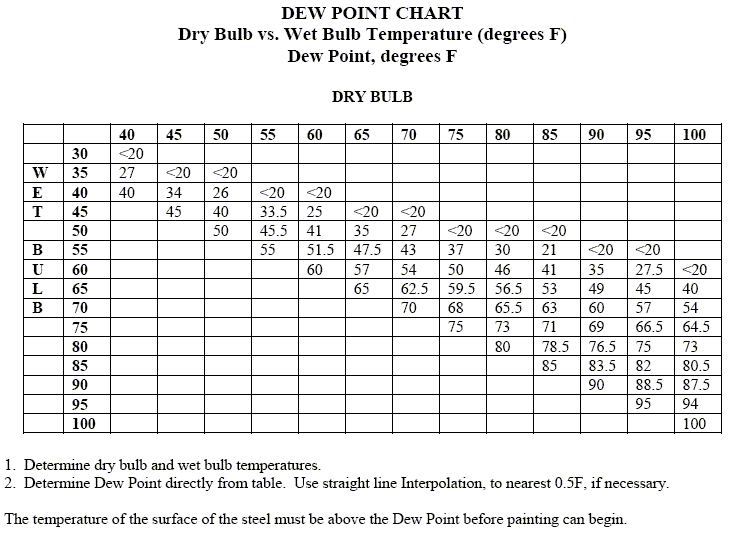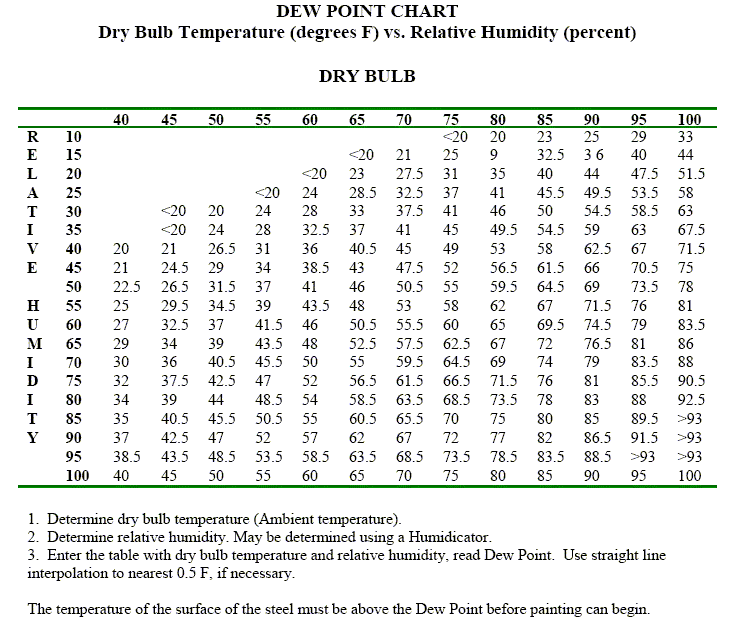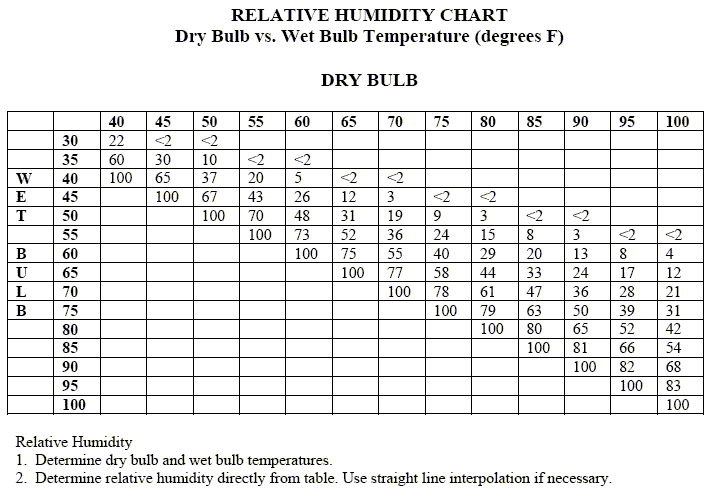106.3.2.38 TM-38, Determination of Dew Point for Structural Steel Painting
This method determines the dew point for painting structural steel.
Contents
106.3.2.38.1 Apparatus
(a) Sling Psychrometer (20°-125° F)
(b) Hygrometer (commercially called Humidicator)
(c) Dry bulb thermometer (20°-125° F)
(d) Surface thermometer (0°-150° F or a 0°-300° F magnetic thermometer)
106.3.2.38.2 Procedure
Dew point will be determined by one of the two procedures included in this test method. Procedure No. 1 is by use of a Sling Psychrometer and is to be considered referee in case of dispute. Procedure No. 2 is by use of any calibrated hygrometer that indicates directly or indirectly the relative humidity of the air. The engineer will determine the procedure to be used for determining dew point.
106.3.2.38.2.1 Procedure No. 1 – Determination of Dew Point by Sling Psychrometer
Determine the dry bulb and wet bulb temperature using a Sling Psychrometer.
The thermometers, wet-bulb coverings, water, location and preparing of the instrument shall be as follows:
(a) Thermometers – Two ASTM Precision Thermometers, either No. 62, 63, or 64, as specified in ASTM Specification E1, for ASTM Thermometers, or thermometers of equivalent or better accuracy. The thermometers shall be matched to one scale division, or better, within the range used and shall be mounted in such a manner as to prevent the air that passes the wet bulb from contacting the dry bulb.
(b) Wet-Bulb Covering – The bulb of the wet-bulb thermometer shall be completely covered with a close-fitting fabric wick of clean muslin, bleached cotton, linen, or other soft unsized material, of a soft-mesh tubular weave. The wick shall extend beyond the bulb and onto the stem of the thermometer, for at least one inch.
(c) Water – Clean water shall be used to wet the wick. If distilled water is available, its use will allow the wick to have a longer effective life. Temperature of the water should be the same as or slightly below the ambient temperature.
(d) Preparing Instrument – Moisten the covering of the wet bulb thoroughly with clean water. A small bottle or porous porcelain cup will serve as a convenient water container. (If a porous porcelain cup is used for storing water, the water will be self-cooled to approximately the correct temperature.) If the wick fabric is new or dry through disuse, several minutes may be required for complete saturation. Avoid touching the fabric with the fingers, which may deposit oil or dirt. Replace the wick when soiled. The dry bulb shall be maintained absolutely dry at all times.
(e) Location – When preparing for and performing the test, avoid locations where proximity to machinery, direct heat from the sun, or other sources of radiation would have undue influence. Stand preferably facing the air current so that the instrument receives the air before the air has passed near you. Greatest accuracy can be achieved when your clothing and skin surface have had time to come into approximate equilibrium with the atmospheric air.
Immediately after whirling the sling for 15-20 seconds, read both thermometers quickly but carefully. Read the wet bulb first. Under ordinary conditions, an approximate 0.27° F (0.15° C) error in wetbulb depression results in a one percent error in relative humidity. While the thermometers are read, keep surfaces at temperatures other than the environment, such as the hands, face, and either warmer or colder objects, as far as possible from the sensitive mercury bulbs.
Repeat the test as many times as necessary until three successive readings agree. It will be necessary to rewet the covering of the wet bulb when the fabric starts to dry, as indicated by change in appearance of the fabric.
After obtaining the dry and wet-bulb temperatures, enter Table 106.3.2.38.3 with these two known points and read dew point directly from the table in degrees F. If necessary, use straight- line interpolation of dew point to the nearest 0.5 °F.
Determine the temperature of the surface of the steel by using a surface thermometer. The surface temperature of the steel must be above the dew point before beginning the painting of structural steel.
106.3.2.38.2.2 Procedure No. 2 – Determination of Dew Point by Dry Bulb Thermometer and Hygrometer
Determine the ambient temperature using the dry bulb thermometer. Obtain the relative humidity from a hygrometer.
The hygrometer shall be calibrated before it is used to determine dew point. The hygrometer shall be considered satisfactory when the percent relative humidity correlates within ± 5 percent as calibrated by using Procedure No. 1 and Table 106.3.2.38.5. After initial calibration, the frequency of calibration will be determined by the engineer but shall be at least once a year.
After obtaining the dry bulb temperature and relative humidity, enter Table 106.3.2.38.4 with these two known points and read dew point directly from the table in degrees F. If necessary, use straight-line interpolation of dew point to the nearest 0.5 F.
Determine the temperature of the surface of the steel using a surface thermometer. The surface temperature of the steel must be above the dew point before beginning the painting of structural steel.


